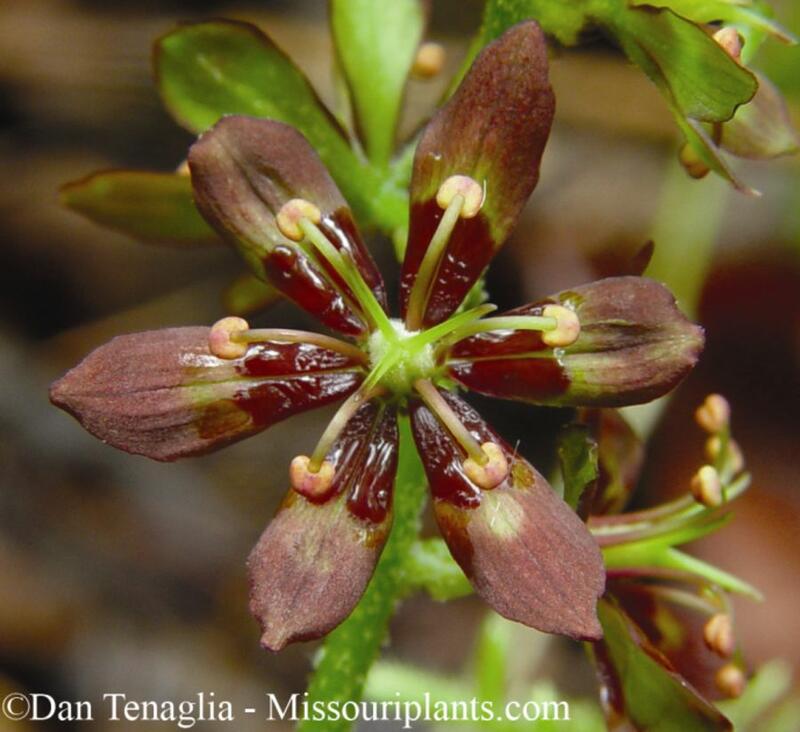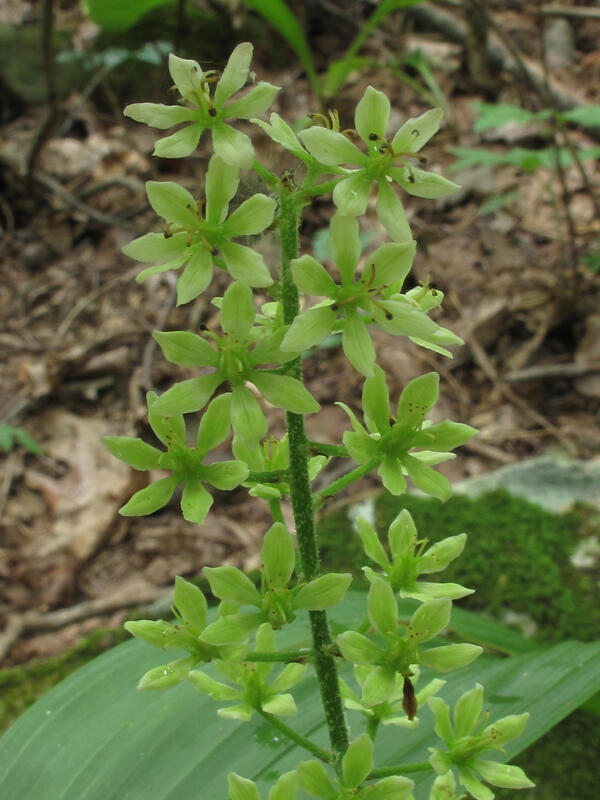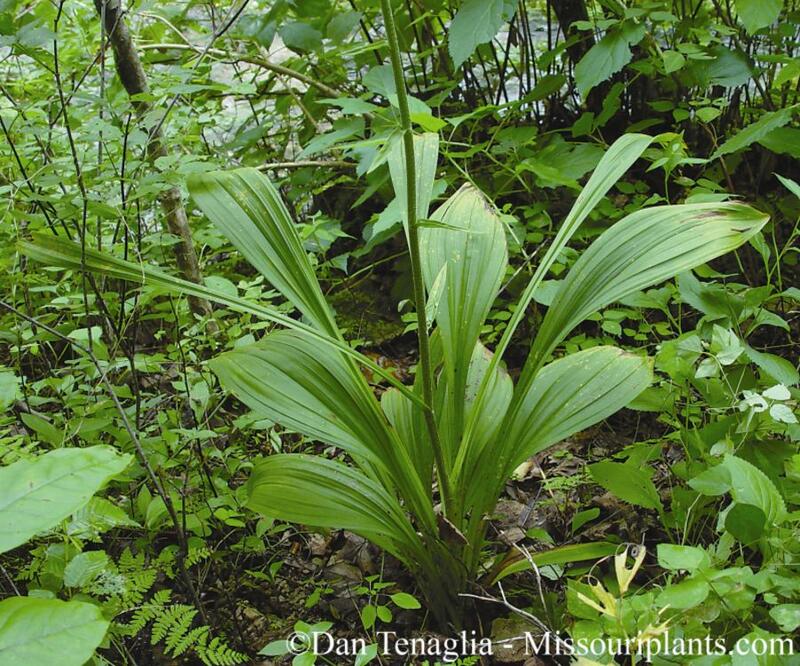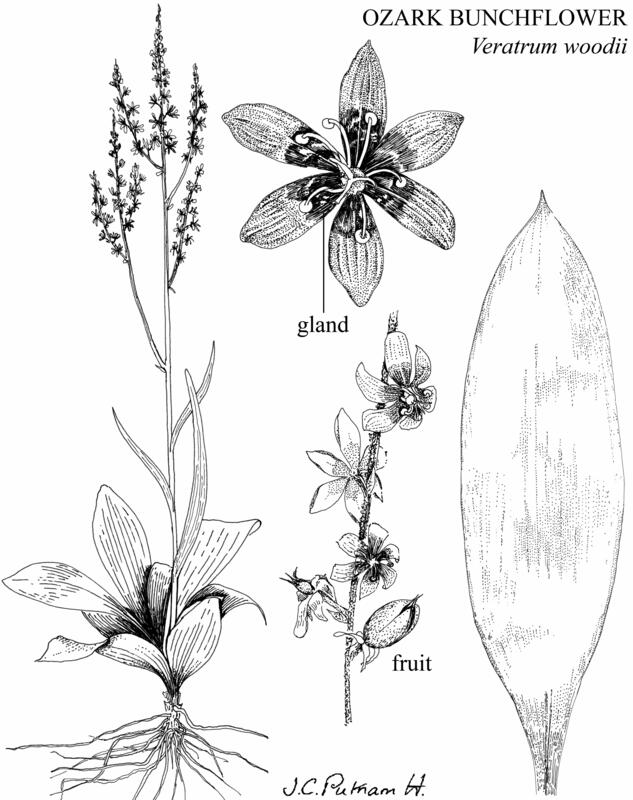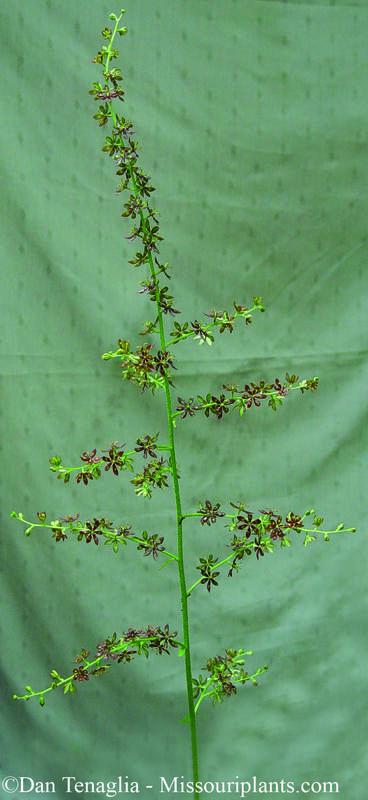







Loading profile. Please wait . . .
Melanthium woodii (J.W. Robbins ex Wood) Bodkin
Ozark Bunchflower




Federal Protection: No US federal protection
State Protection: Rare
Global Rank: G5
State Rank: S2
Element Locations Tracked in Biotics: Yes
SWAP 2015 Species of Greatest Conservation Need (SGCN): Yes
SWAP 2025 Species of Greatest Conservation Need (SGCN): Yes
2025 SGCN Priority Tier: Moderate Conservation Concern
Element Occurrences (EOs) in Georgia: 31
Habitat Summary for element in Georgia: Mesic hardwood forests over basic soils
Melanthium woodii (synonym Veratrum woodii) is a perennial herb with short vertical rhizomes, a deeply buried bulb, an erect flowering stem, and most leaves in a basal rosette. Its basal leaves are 8 - 24 inches (20 - 60 cm) long and 1 - 4 inches (3 - 10 cm) wide, oval, with raised parallel veins giving the surfaces a slightly pleated look. The stem leaves (actually bracts) are few, smaller, and widely spaced. The flowering stem is up to 6.5 feet (2 meters) tall, the middle and upper sections with many slender, flowering branches. The flowers are about 0.8 inch (2 cm) wide, with 6 tepals (3 petals + 3 sepals), maroon, turning green with age; each tepal has 2 shiny, dark glands at the base. Fruits are 3-lobed capsules up to 1 inch (1.8 - 2.5 cm) long, held erect at the tip of short stalks.
Mountain Bunchflower (Melanthium parviflorum, synonym Veratrum parviflorum) has similar but larger basal leaves that are 1.8 - 5.5 inches (4.5 - 14 cm) wide; its flowers are greenish-yellow and about 0.5 inch (1.4 cm) wide; it occurs in moist, hardwood forests in north Georgia.
Broad-leaved Bunchflower (Melanthium hybridum, synonym Veratrum hybridum), occurs in moist, hardwood forests in the mountains, Piedmont, and upper Coastal Plain; its leaves are strap-shaped, 10 - 21.5 inches (25 - 55 cm) long and 0.4 - 2.8 inches (1 - 7 cm) wide; its flowers are greenish-yellow, and the tepals are nearly as wide as long and abruptly narrowed at the base, with undulate margins and 2 conspicuous glands.
American False Hellebore (Veratrum viride, Special Concern) resembles Ozark Bunchflower. It has similar leaves up to 2.4 - 6 inches (6 - 15 cm) wide but the stem is leafier, and its greenish-yellow flowers are hairy and 0.3 - 0.5 inch (0.8 - 1.3 cm) wide, with a conspicuous pair of glands near the base of the tepal; it occurs in seepy, hardwood forests in northeast Georgia.
Lower slopes and stream terraces in moist, hardwood forests, usually over basic soils.
Ozark Bunchflower is a perennial herb that reproduces sexually and possibly vegetatively. Sexual reproduction is limited as plants flower infrequently, with stands of apparently mature plants producing no flowers for several years or only one flowering stem in a given year. Drought seems to stimulate flowering in some populations. Inflorescences include both perfect and male flowers, with male flowers found mostly on branches at mid-inflorescence. Pollinators have not been studied but the colorful, nectar-producing flowers of Ozark bunchflower seem likely to attract bees, moths, flies, and butterflies. Seed set is low. Other species of Melanthium/Veratrum spread by rhizomes, and it seems possible that the bulbs produce offsets, but vegetative reproduction has not been reported for Ozark Bunchflower. Populations are believed to be long-lived; one stand in Illinois was known to persist for 50 years. Melanthium/Veratrum species are known for their highly toxic steroidal alkaloids, concentrated in the roots, bulbs, and seeds, which can cause cardiac failure and death.
Surveys are best conducted during flowering (July–September); however, plants may flower only every few years.
Georgia, Florida, Alabama, North Carolina, Tennessee, Kentucky, Arkansas, Illinois, Indiana, Iowa, Missouri, Ohio, and Oklahoma. It is rare throughout much of its range.
Logging, clearing, and development of mature hardwood forests, browsing by deer, competition from exotic pest plants, rooting by feral hogs.
| Threat 1 | Threat 2 | Threat 3 | |
|---|---|---|---|
| General Threat | Natural system modifications | Residential & commercial development | None |
| Specific Threat | None | None | None |
Melanthium woodii is ranked S2 by the Georgia Department of Natural Resources, indicating that the species is imperiled in Georgia. It is listed as Rare by the State of Georgia. Thirty populations have been documented in Georgia since the 1940s, 6 on conservation lands and 3 on Army Corps of Engineers land. Only 13 populations have been confirmed since 2000.
Avoid logging and mechanical clearing. Reduce the size of Georgia’s deer population. Eradicate exotic pest plants such as Japanese Honeysuckle.
Bodkin, N.L. and F.H. Utech. 2003. Melanthium woodii species account. Flora of North America, Vol. 26. Oxford University Press, New York. http://beta.floranorthamerica.org/Melanthium_woodii
Chafin, L.G. 2007. Field guide to the rare plants of Georgia. State Botanical Garden of Georgia and University of Georgia Press, Athens.
Ebinger, J. 1996. Flowering in false hellebore (Veratrum woodii, Liliaceae) populations in east-central Illinois. Castanea 61(1): 46-48. https://www.jstor.org/stable/4033749?seq=1#metadata_info_tab_contents
Kral, R. 1983. A report on some rare, threatened, or endangered forest-related vascular plants of the South. Technical Publication R8-TP2. United States Forest Service, Atlanta.
NatureServe. 2020. Melanthium woodii species account. NatureServe Explorer. NatureServe, Arlington, Virginia. https://explorer.natureserve.org/Taxon/ELEMENT_GLOBAL.2.160247/Melanthium_woodii
Patrick, T.S., J.R. Allison, and G.A. Krakow. 1995. Protected plants of Georgia. Georgia Department of Natural Resources, Natural Heritage Program, Social Circle.
Radford, A.E., H.E. Ahles, and C.R. Bell. 1968. Manual of the vascular flora of the Carolinas. University of North Carolina Press, Chapel Hill.
Tenaglia, D. 2006. Veratrum woodii J.W. Robbins ex Alph. Wood, False Hellebore. Missouri plants: photographs and descriptions of flowering and non-flowering plants of Missouri. http://www.missouriplants.com/Veratrum_woodii_page.html
Weakley, A.S. 2015. Flora of the southern and mid-Atlantic States. University of North Carolina Herbarium, University of North Carolina, Chapel Hill. http://www.herbarium.unc.edu/flora.htm
Weakley, A.S., and Southeastern Flora Team. 2025. Flora of the southeastern United States Web App. University of North Carolina Herbarium, North Carolina Botanical Garden, Chapel Hill, U.S.A. https://fsus.ncbg.unc.edu/main.php?pg=show-taxon-detail.php&lsid=urn:lsid:ncbg.unc.edu:taxon:{B81C00D3-A092-4B19-8A35-B8873CC2BE97}. Accessed Feb 24, 2025.
Zomlefer, W.B., W.M. Whitten, N.H. Williams, and W.S. Judd. 2003. Overview of Veratrum s.l. (Liliales: Melanthiaceae) and an infrageneric phylogeny based on ITS sequence data. Systematic Botany 28(2): 250-269. https://bioone.org/journals/Systematic-Botany/volume-28/issue-2/0363-6445-28.2.250/An-Overview-of-Veratrum-sl-Liliales--Melanthiaceae-and-an/10.1043/0363-6445-28.2.250.full
Linda G. Chafin
L.Chafin, Jan. 2009: original account
D.Weiler, Jan. 2010: added pictures
Z. Abouhamdan, April 2016: updated link
L. Chafin, June 2020: updated original account.
H. Umstead, February 2025: updated scientific names and synonyms.
